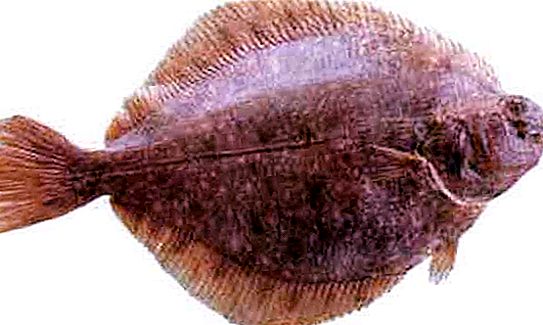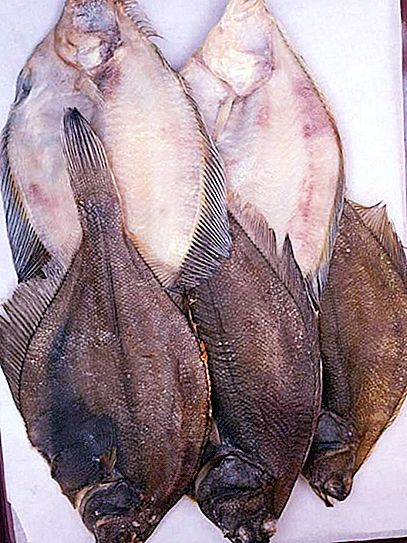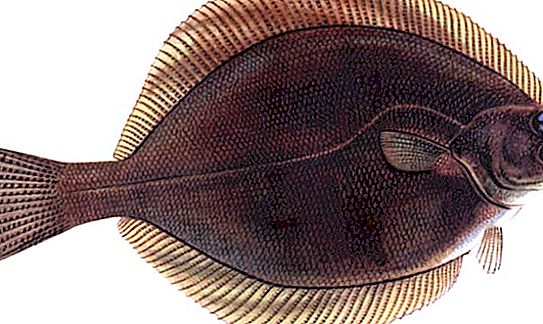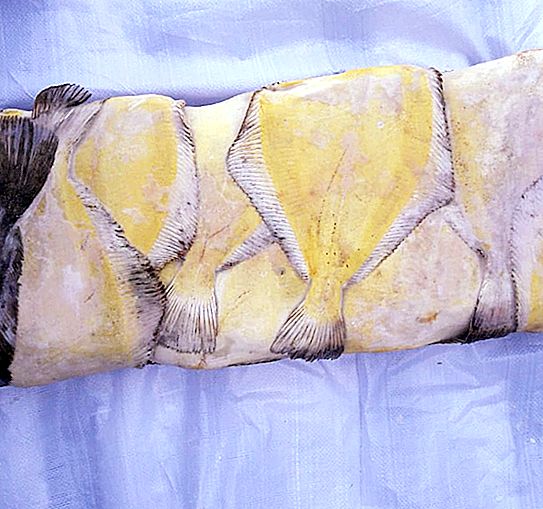Basically, the representatives of this family are typical demersal fish, which are characterized by the locality of individual populations in limited water areas. Their migrations are small in length, and wintering takes place within a small area with the formation of sedentary, high density, clusters. We are talking about flounder, which is called yellow-bellied.
Fish characteristic
Fish spawns and spawns in cycles in coastal areas. The population size depends on the living conditions. Its fluctuations are within small limits. Fish is often subjected to overly intensive fishing.

Platichthys quadrituberculat (yellow-bellied flounder) is a family of pleuronectidae (flatfish).
The eyes of fish of this kind are located on the left side of the body. The diameter of her eye is equal to the length of the snout, or even more. 4-6 sharp conical bone tubercles are located behind the upper eye. Therefore, this yellow-bellied flounder is also called four-humped.
Her body is wide and covered with smooth scales of the cycloid type. The lateral line has a slight bend. The side on which there are no eyes is called blind. It is painted in a lemon yellow color. The ocular side of the other is brownish-brown with a marbled pattern. Sometimes it has vague dark spots. The length of the fish reaches 60 centimeters, and weight - up to 3 kg.
Where is yellow-bellied flounder common?
Basically, it lives along the Asian and American coasts. These are the directions:
- from Peter the Great Bay (only a few specimens) to Providence Bay;
- from the southeastern part of the Chukchi Sea to the Gulf of Alaska;
- areas west of Cape Spencer;
- in Kotzebue Bay, it is 84-88%;
- in Norton Bay - 88-91%;
- in the Bering Strait - 17-35%;
- in the Sea of Japan, it occurs mainly in the north;
- in the Tatar Strait (northern part), this fish is considered a common type;
- in the Sea of Okhotsk, yellow-bellied flounder is found everywhere from the coast of Hokkaido Island and Aniva Bay to the northernmost part;
- sometimes this fish is caught in the Sakhalin Gulf, at Ayan and Shantar;
- Dense clusters are found in Terpeniya Bay and Western Kamchatka;
- In the Bering Sea, its stable and relatively isolated accumulations are found in the Olyutor, Korfo-Karagin, Anadyr bays, Natalia Bay and in the eastern part of the sea.

This type of flounder is more common in the waters of the American coast than in the Asian.
Biology and lifestyle
This is a sea bottom fish that lives in relatively shallow waters (up to 300 meters in the Sea of Okhotsk and the Sea of Japan). She prefers salt water and leaves fresh areas. As you know, certain seawater is rich in iodine. That is why the flounder is yellow and, when caught, a special smell is often heard. It smells like iodine.
It has the property of a fairly clear pronounced seasonal migration. In the summer, the bulk of this flounder is at a depth of less than 100 meters. The maximum catch is usually reached between isobaths of 20 and 70 meters. In late autumn and already in winter, a fish of this species migrates to the dump, concentrating on isobaths from 100-150 meters and the water temperature at the very bottom above 0 ° С. Moreover, its part is on the middle shelf, where there is a negative temperature. Maximum fish prefers water temperature of 3-4 ° C.

This fish is predatory. It uses about 107 species of small inhabitants of the aquatic environment for food. But worms, crustaceans and mollusks prevail in food. By the nature of its nutrition, the fish belongs to the type of “benthophage-polyphage”.
This large fish lives about 22 years. Flounder from 5 to 12 years prevails in the catch. On average, its length is 24-48 cm. The mass of such fish is 300-1400 g. Flounder is a cold-loving euryhaline species.
Off the coast of Primorye is found almost everywhere. Peter the Great Bay is the southern boundary of the range of flounder yellow-bellied.
Kinds
Yellow-bellied flounder is very similar in nutritional indicators to yellowfin flounder.
These two species have the largest biomass. Food similarity in juveniles reaches 51%.
Interestingly, there are about 570 species of flounder in the world and only three of them live in fresh water. In the Japanese, Bering and Okhotsk seas, flounder yellow-bellied and white-bellied are found. What is the difference between the two?

First of all, in the color of the blind side of the body. White-bellied grows up to 50 cm, although usually 30-35 cm of fish is on sale. She has a white color on the blind side and an unusual sharp bend in the side line.
Cookery
White-bellied flounder is highly regarded in cooking. She has white meat with the scent of fresh sea. It is practically without small bones and does not have a pronounced smell of fish. It is prepared in any way. In cooking valued flounder yellow-bellied and white-bellied. Which is tastier is a moot point. To each his own. But white-bellied fish is often preferred due to its versatility and lack of a specific smell of iodine.
Flounder refers to diet foods. Its meat has high nutritional value and easy digestibility. It is rich in polyunsaturated fats that can protect the human body from intense aging and cancer. White-bellied and yellow-bellied flounders are no exception. Differences between these species in terms of meat value are insignificant. But we can say that yellow-bellied is saturated with iodine to a greater extent. This affects cooking methods.
Breeding
Yellowfish flounder spawning is found in all areas of its large concentration. This mainly occurs at a depth of 180-200 meters. But even at greater or lesser depths, spawning individuals can be found. Regarding the density of spawning clusters, it can be noted that its high level is usually not manifested.
The breeding season lasts from March to July. This is mainly the time of hydrological spring. The spawning periods to the north are slightly shifted towards summer, but in general, the period of mass spawning is May-June and, in part, the end of April. The eastern part of the Bering Sea is characterized by a flounder spawning pattern at a bottom temperature of 2-4 ° C, and on the surface - 0-1 ° C.

Juveniles are mainly kept near the coast, going to depths of less than 20 meters.
The yellow-bellied flounder spawning off the Kamchatka coast is the basis of the summer coastal trawl fishing. In the Kamchatka Gulf, this fish is caught in the coastal complex.
Why does the flounder have a yellow abdomen, and how to understand whether it is fresh or not?
This is a large fish: on sale found in lengths and up to 40 centimeters. Its distinguishing feature is the yellow, even lemon, color of the blind side of the body. Flounder refers to commercial fish. It contains a large amount of minerals and vitamins, is rich in Omega-3. Of particular value to the meat is the high iodine content.
Therefore, people with a deficiency of this microelement are recommended such a flounder for regular use. When this fish is fresh, it has a specific smell of iodine. This is how quality is determined upon purchase. If the yellow color is not in the fish itself, but in the form of a formed coating on the surface of the carcass, then you cannot eat flounder. This indicates repeated freezing of the product.
Understanding why flounder has a yellow belly, what fresh fish smells and what is the difference between its own color and the formed plaque, will protect the buyer from adverse health effects. You should always be careful when buying fish, as poisoning with this product is very dangerous.
Market and catch
For sale flounder yellow-bellied comes in ice cream or fresh. Freezing can be both in the glaze, and without it. In addition, on sale you can find flounder in the finished form: salted, dried, smoked (spicy, cold or hot cooking).

From the shore it is caught with carp rods and feeders, and from the boat it is sheared by shear. For sea fishing, special equipment is recommended. These are sea rods that are more resistant to salt water.
The bait is any protein feed. For example, small fish, shellfish, crabs, worms and squid. Some fishermen manage to catch flounder even on sausage.
Special tackle-riders are popular for such fishing: a nylon cord, a heavy sinker is attached to one end of it, and a buoy is attached to the other. Its length is equal to the depth at the place of fishing (approximately). A separate piece of fishing line, leashes with hooks and bait (up to 4 pieces) are tied to the weighted end.




